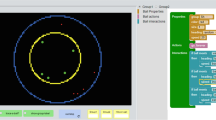Abstract
This study investigates the effect of using a realistic situation with modeling characteristics in creating and resolving a cognitive conflict to promote understanding of a changing reference in fraction calculations. The study was conducted among 96 seventh graders divided into 2 experimental groups and 1 control group. The experimental groups coped with a realistic modeling situation in which they had to increase, then decrease, the size of a bag of fries. Results indicate conceptual change and better understanding of the changing reference among students in the experimental groups. The article describes their learning process, showing how their analysis of the situation promoted conflict resolution.
Similar content being viewed by others
References
Chan, C., Burtis, J. & Bereiter, C. (1997). Knowledge building as a mediator of conflict in conceptual change. Cognition and Instruction, 15(1), 1–40.
D’Ambrosio, B. S. & Campos, T. M. M. (1992). Pre-service teachers’ representations of children’s understanding of mathematical concepts: conflicts and conflict resolution. Educational Studies in Mathematics, 23, 213–230.
Druyan, S. (2001). A comparison of four types of cognitive conflict and their effect on cognitive development. International Journal of Behavioral Development, 25(3), 226–236.
English, L. D. & Fox, J. L. (2005). Seven-graders mathematical modeling on completion of a 3-year program. In P. Claarson et al. (Eds.), Building connections: theory, research and practice (Vol. 1, pp. 321–328). Melbourne: Deakin University Press.
Foster, C. (2011). A slippery slope: resolving cognitive conflict in mechanics. Teaching Mathematics and its Applications, 30(4), 216–22.
Freudenthal, H. (1971). Geometry between the devil and the deep sea. Educational Studies in Mathematics, 3, 413–435.
Gravemeijer, K. & Doorman, M. (1999). Context problems in realistic mathematics education: a calculus course as an example. Educational Studies in Mathematics, 39, 111–129.
Gravemeijer, K. & Stephan, M. (2002). Emergent models as an instructional design heuristic. In K. Gravemeijer, R. Lehrer, B. Oers & L. Verschaffel (Eds.), Symbolizing, modeling and tool use in mathematics education (pp. 145–169). Dordrecht: Kluwer.
Gravemeijer, K. & Terwel, J. (2000). Hans Freudenthal: a mathematician on didactics and curriculum theory. Curriculum Studies, 32(6), 777–796.
Huang, T. H., Liu, Y. C. & Shiu, C. Y. (2008). Construction of an online learning system for decimal numbers through the use of cognitive conflict strategy. Computers & Education, 50(1), 61–76.
Kang, S., Scharmann, L. C., Noh, T. & Koh, H. (2010). Cognitive conflict and situational interest as factors the influencing conceptual change. International Journal of Environmental and Science Education, 5(4), 384–405.
Lesh, R. A. & Doerr, H. M. (2003). Beyond constructivism: models and modeling perspectives in mathematics teaching, learning, and problem solving. Mahwah, NJ: Lawrence Erlbaum.
Lesh, R., Hoover, M., Hole, B., Kelly, A. & Post, T. (2000). Principle for developing thought revealing activities for students and teachers. In R. Lesh & A. Kelly (Eds.), Handbook of research design in mathematics and science education (pp. 591–644). Mahwah, NJ: Lawrence Erlbaum.
Limón, M. (2001). On the cognitive conflict as an instructional strategy for conceptual change: a critical appraisal. Learning and Instruction, 11, 357–380.
Liu, T.–C. (2010). Developing simulation-based computer assisted learning to correct students’ statistical misconceptions based on cognitive conflict theory, using “correlation” as an example. Educational Technology and Society, 13(2), 180–192.
Mansoor, N. (1995). Cognitive conflict as a teaching strategy in solving chemistry problems: a dialectic–constructivist perspective. Journal of Research in Science Teaching, 32(9), 895–1005.
Moody, B. (2010). Connecting the points: cognitive conflict and decimal magnitude. In L. Sparrow, B. Kissane & C. Hurst (Eds.), Shaping the future of mathematics education. Proceedings of the Annual Conference of The Mathematics Education Research Group of Australasia (pp. 422–429). Fremantle: MERGA.
Parker, J. (2006). Exploring the impact of varying degrees of cognitive conflict in the generation of both subject and pedagogical knowledge as primary trainee teachers learn about shadow formation. International Journal of Science Education, 28(13), 1545–1577.
Peled, I. & Shahbari, J. A. (2009). Journey to the past: verifying and modifying the conceptual sources of decimal fraction knowledge. Canadian Journal of Science, Mathematics, and Technology Education, 9(2), 73–85.
Peled, I. & Suzan, A. (2011). Prospective teachers experiencing the power of intuitive knowledge involving percentages. In J. Novotna & H. Moraova (Eds.), Proceedings of the International Symposium Elementary Mathematics Teaching (SEMT) (pp. 267–275). Prague: Charles University.
Piaget, J. (1985). The equilibration of cognitive structures. Chicago, IL: University of Chicago Press (Original work published in 1975).
Shahbari, J. A. & Peled, I. (2012). Constructing the percent concept through integrative modeling activities based on the realistic approach. In T. Y. Tso (Ed.), Proceedings of the 36th Conference of the International Group for the Psychology of Mathematics Education (Vol. 4, pp. 67–74). Taipei: PME.
Van den Heuvel-Panhuizen, M. (1994). Improvement of (didactical) assessment by improvement of problems: an attempt with respect to percentage. Educational Studies in Mathematics, 27, 341–372.
Watson, J. M. (2007). The role of cognitive conflict in developing students’ understanding of average. Educational Studies in Mathematics, 65, 21–47.
Zazkis, R. & Chernoff, E. (2008). What makes a counterexample exemplary? Educational Studies in Mathematics, 68(3), 195–208.
Zohar, A. & Kravetsky, S. A. (2005). Exploring the effects of cognitive conflict and direct teaching for students of different academic levels. Journal of Research in Science Teaching, 42(7), 829–855.
Author information
Authors and Affiliations
Corresponding author
Rights and permissions
About this article
Cite this article
Shahbari, J.A., Peled, I. RESOLVING COGNITIVE CONFLICT IN A REALISTIC SITUATION WITH MODELING CHARACTERISTICS: COPING WITH A CHANGING REFERENCE IN FRACTIONS. Int J of Sci and Math Educ 13, 891–907 (2015). https://doi.org/10.1007/s10763-014-9509-1
Received:
Accepted:
Published:
Issue Date:
DOI: https://doi.org/10.1007/s10763-014-9509-1




